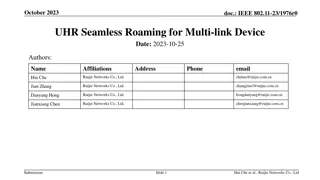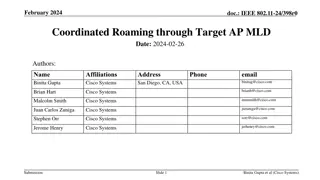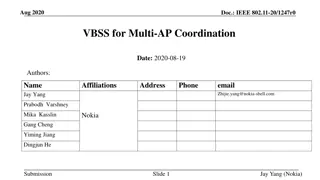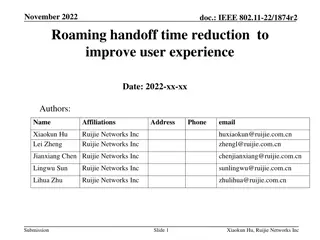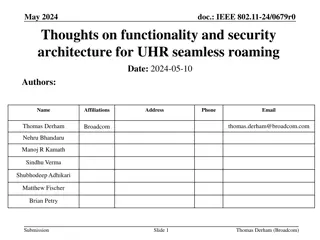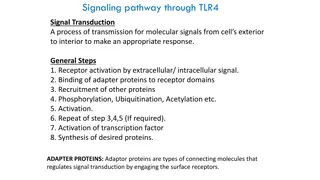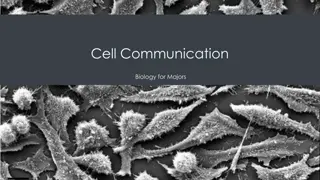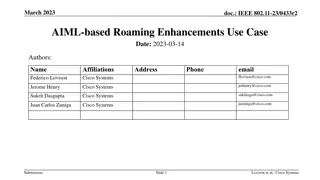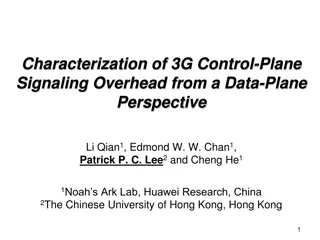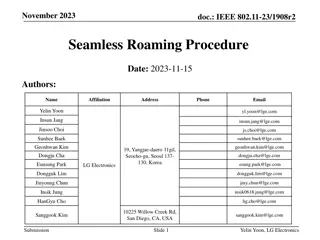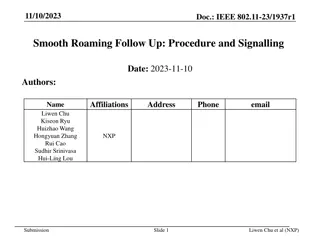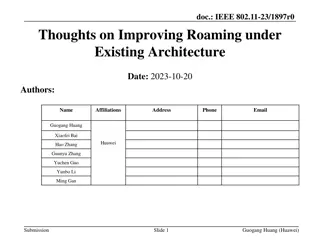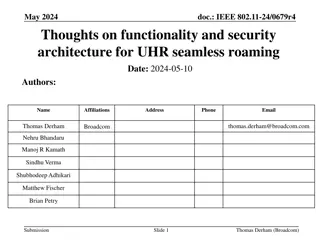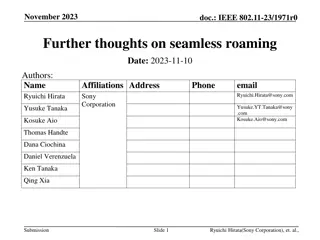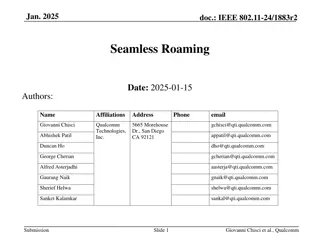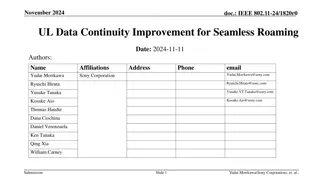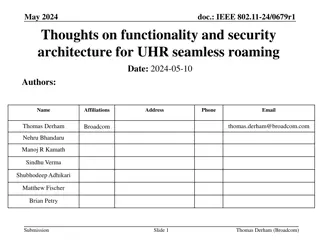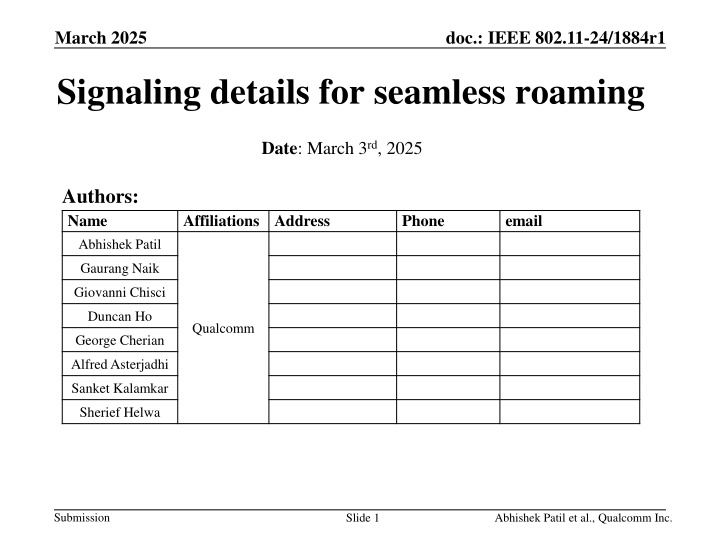
IEEE 802.11-24/1884r1 Seamless Roaming Signaling Details
Explore the signaling requirements for seamless roaming in IEEE 802.11-24/1884r1 standard document. Learn about the phases involved, challenges, and potential signaling options while minimizing signaling overheads. Dive into the Discovery phase, beacon bloating issue, and more to enhance your understanding of seamless transition between AP MLDs.
Download Presentation

Please find below an Image/Link to download the presentation.
The content on the website is provided AS IS for your information and personal use only. It may not be sold, licensed, or shared on other websites without obtaining consent from the author. If you encounter any issues during the download, it is possible that the publisher has removed the file from their server.
You are allowed to download the files provided on this website for personal or commercial use, subject to the condition that they are used lawfully. All files are the property of their respective owners.
The content on the website is provided AS IS for your information and personal use only. It may not be sold, licensed, or shared on other websites without obtaining consent from the author.
E N D
Presentation Transcript
March 2025 doc.: IEEE 802.11-24/1884r1 Signaling details for seamless roaming Date: March 3rd, 2025 Authors: Name Abhishek Patil Affiliations Address Phone email Gaurang Naik Giovanni Chisci Duncan Ho Qualcomm George Cherian Alfred Asterjadhi Sanket Kalamkar Sherief Helwa Submission Slide 1 Abhishek Patil et al., Qualcomm Inc.
March 2025 doc.: IEEE 802.11-24/1884r1 Introduction Previous discussions and contributions have explained the high-level phases involved in facilitating seamless transition of a client from one AP MLD to another: Discovery phase The client discovers the serving AP MLD s neighborhood. Preparation phase The client selects one of the candidate AP MLD for roaming and makes a request to add links of that candidate AP MLD to its exiting ML setup. the serving AP MLD and client may work together to determine candidate set of AP MLD(s) that are suitable for the client. The static context related to the client is made available to the selected candidate Execution phase During this phase, the client roams to the target AP MLD (i.e., the selected candidate AP MLD). The dynamic context related to the client is made available at the target AP MLD Submission Slide 2 Abhishek Patil et al., Qualcomm Inc.
March 2025 doc.: IEEE 802.11-24/1884r1 Objective The objective of this document is To examine the signaling requirements during each phase, To provide one or more mechanisms to meet the signaling needs in each step by leveraging existing frameworks, and To minimize signaling overheads (esp. beacon bloating). For each phase, the document lays out the requirement, challenges and potential signaling options while proposing minimal deviation from baseline standard. Submission Slide 3 Abhishek Patil, Qualcomm Inc.
March 2025 doc.: IEEE 802.11-24/1884r1 Discovery Phase Purpose: As the non-AP moves from one AP MLD to another AP MLD, it needs to determine the new neighborhood so that it can make roaming related preparations. Clients mobility Serving APs along clients mobility path Initial association Transition (roam) to next AP MLD Submission Slide 4 Abhishek Patil, Qualcomm Inc.
March 2025 doc.: IEEE 802.11-24/1884r1 Discovery phase: Issue of beacon bloating Traditionally, RNR has been the mechanism to provide basic information of a reported AP. Brief background on RNR (see appendix for RNR format). Defined by 11af for reporting neighborhood. However, commonly employed for reporting collocated APs mandated by 11ax (for 6 GHz discovery) and then by 11be (for MLO) The standard puts no requirements about reporting non-collocated APs Each entry for a reported AP requires 16 bytes. Now, each AP MLD in a seamless mobility domain (SMD) is expected to have at least 2 links If TGbn were to require reporting of non-collocated AP MLDs in the neighborhood, it will result in significant incase in beacon size For example, with 5 AP MLDs in the neighborhood, each having just 2 link, and assuming TGbn adds no new fields to RNR, the beacon size grows by (10x16=) 160 bytes. Submission Slide 5 Abhishek Patil, Qualcomm Inc.
March 2025 doc.: IEEE 802.11-24/1884r1 Discovery phase: Issue of beacon bloating In addition to long medium occupancy, there have been several other issues identified due to a large beacon size For example, legacy STAs disconnect (and start probing) when beacon length exceeds a certain size As a result, there are on-going efforts to curb the size of a Beacon frame. In other words, traditional RNR based discovery via Beacon frames does not scale for discovery of non-collocated AP MLD Proposal: TGbn must not require (i.e., mandate) reporting of non-collocated APs in the RNR IE carried in the Beacon frame and must provide alternatives to RNR for a client to discovery APs in the neighborhood that belong to the same SMD. Same considerations apply for FILS Discovery frame. Submission Slide 6 Abhishek Patil, Qualcomm Inc.
March 2025 doc.: IEEE 802.11-24/1884r1 RNR considerations If a deployment scenario allows (e.g., beacon size is short), then the beacon may report neighboring AP MLDs belonging to the same SMD. Recommend not to carry neighboring AP MLD information in RNR IE contained in a FILS Discovery frame. (ML)Probe Response can include information about neighboring AP MLD in the RNR IE Considerations When RNR carries information of non-collocated AP MLD A bit field identifies a report AP (MLD) as belonging to the same SMD (e.g., B7 in BSS Parameters subfield) Similar considerations apply for Neighbor Report element. The MLD Parameters subfield of the RNR IE corresponding to a reported non-collocated AP provide the AP MLD ID and the Link ID information for that AP (and its MLD). The value carried in the AP MLD ID field is based on the rules in 9.4.2.169.2 TGbn must require all affiliated APs of an AP MLD to designate the same value of AP MLD ID to a neighboring (reported) AP MLD. This will keep the AP MLD ID value for a reported AP MLD consistent across all links of the reporting AP MLD. As a result, discovery, roam preparation and roam execution can be performed independently on any link. The same AP MLD can be assigned a different AP MLD ID when a different AP MLD reports it. E.g., all affiliated APs of AP MLD 2 refer to AP MLD 1 with AP MLD ID value of 25 while all affiliated APs of AP MLD 3 use AP MLD ID of 36 when referring to AP MLD 1 Submission Slide 7 Abhishek Patil, Qualcomm Inc.
March 2025 doc.: IEEE 802.11-24/1884r1 Probing/BTM to fill a potential gap This slide provides alternatives (using existing tools) to fill-in a potential gap if RNR carried in a Beacon frame does not carry information of neighboring AP MLDs belonging to the same SMD. Case 1: Before initial (SMD) association, determine neighborhood information via active scanning. (ML) probe response can, via RNR, provide information about other AP MLDs in the neighborhood Client can also gather specific information (i.e., partial profile) for links belonging to another AP MLD by including (Extended) Request element in the ML probe request [see 35.3.4.2] Case 2: After SMD association, leverage BTM framework to gather neighborhood information in a protected manner. The client s BTM Query frame can convey its intention to discovery the neighborhood via (a new value defined for) the BTM Transition Query Reason. The response (BTM Request frame) from the AP provides basic information about each neighbor (i.e., limited or no subelements in NR IE). Alternatively, or in addition, the serving AP MLD can send an unsolicited BTM Request frame to provide information about the neighborhood Such unsolicited BTM Request frame could be broadcasted periodically by the serving AP MLD to help multiple non-APs In summary, leverages baseline frameworks (i.e., probing and/or BTM) to fill a potential gap created due to missing RNR entries for non-collocated APs belonging to the same SMD No new mechanism need to be defined and minimal extensions to baseline (if needed) Submission Slide 8 Abhishek Patil, Qualcomm Inc.
March 2025 doc.: IEEE 802.11-24/1884r1 Optional Recommendation phase When the client wants to get ready for roaming, it can send a BTM Query frame to its serving AP MLD to determine suitable candidate AP MLD(s). The client may include the BSS Transition Candidate List Entries field if it has a preferred set. A new value defined for the BSS Transition Query Reason field will convey the intention of the non-AP s query. The serving AP MLD s BTM Request frame provides information about one or more candidate AP MLDs that are recommended for the non-AP. An AP may send an unsolicited BTM Request frame recommending candidate AP MLD(s) for the client. A non-AP MLD can initiate link preparation by sending a Link Reconfiguration Request to any of the candidate AP. See appendix for format details Submission Slide 9 Abhishek Patil, Qualcomm Inc.
March 2025 doc.: IEEE 802.11-24/1884r1 Adding link of target AP MLD When client is preparing to roam to the target AP MLD, it transmits a Link Reconfiguration Request frame to its serving AP MLD carrying Reconfig Multi-Link element to prepare the target AP MLD. The Common Info field of the element includes a field to carry the MLD MAC address of the target AP MLD and may include TBD parameters pertaining to roaming. The Per-STA Profile subelement carries information of the link that are requested to be added The link ID values are with respect to the target AP MLD. Link Reconfiguration Response frame from the serving AP indicates which links are accepted. Include Basic Multi-Link element carrying per-STA profile of the links that have been accepted. Submission Slide 10 Abhishek Patil, Qualcomm Inc.
March 2025 doc.: IEEE 802.11-24/1884r1 Transition phase A client sends a roam request to transition to the target AP MLD. Invokes dynamic context transfer (e.g., SN/PN). Triggers a DS mapping switch. The roam request can be Link Reconfiguration Request frame carrying an indication that is a request to transition to the target. Since the target AP is already prepared and its links added to the clients ML setup, the contents of the frame are expected to be light. i.e., per-STA profile need not be included. Cleanup: Links to the old serving AP MLD are deleted either implicitly after a certain time out period or explicitly (before the timeout period expires). Use baseline Link Reconfiguration procedures for the deletion Explicit deletion may be performed after receiving an indication from old serving AP MLD that it has completed draining pending DL BUs (if any). Submission Slide 11 Abhishek Patil, Qualcomm Inc.
March 2025 doc.: IEEE 802.11-24/1884r1 Submission Abhishek Patil, Qualcomm Inc. Slide 12
March 2025 doc.: IEEE 802.11-24/1884r1 Summary The contribution discusses the signaling details involved during the discovery, roaming preparation, and roaming execution for the seamless roaming feature. Explains why a UHR AP must not be required to report non-collocated APs in RNR element carried in a Beacon frame Explains how existing BTM and/or (ML)probing framework acts as an alternatives to RNR Proposes to use EHT Link Reconfiguration framework during preparation and roaming phase Overall, the objective is to leverages or extend existing framework with minimal additions to the standard to enable each functionality. Submission Slide 13 Abhishek Patil, Qualcomm Inc.
March 2025 doc.: IEEE 802.11-24/1884r1 APPENDIX Submission Slide 14 Abhishek Patil, Qualcomm Inc.
March 2025 doc.: IEEE 802.11-24/1884r1 Reduced Neighbor Report element BACK Submission Slide 15 Abhishek Patil, Qualcomm Inc.
March 2025 doc.: IEEE 802.11-24/1884r1 BTM frame formats BACK Slide 16 Submission Abhishek Patil, Qualcomm Inc.
March 2025 doc.: IEEE 802.11-24/1884r1 STRAW-POLLS Submission Slide 17 Abhishek Patil, Qualcomm Inc.
March 2025 doc.: IEEE 802.11-24/1884r1 SP 1 Do you support that TGbn does not define a requirement for a UHR AP to report non-collocated APs in the Reduced Neighbor Report element that is carried in its Beacon and FILS Discovery frames? Submission Slide 18 Abhishek Patil, Qualcomm Inc.
March 2025 doc.: IEEE 802.11-24/1884r1 SP 2 Do you support that the Link Reconfiguration Request/Response frames (with necessary extensions) shall be used as the roaming preparation Request/Response frames? The Per-STA Profile subelement of the Multi-Link shall be present and each corresponds to the requested/accepted links TBD signaling to indicate that the request is to initiate roaming preparation Other extension (if needed) TBD Submission Slide 19 Abhishek Patil, Qualcomm Inc.
March 2025 doc.: IEEE 802.11-24/1884r1 SP 3 Do you support that the Link Reconfiguration Request/Response frames (with necessary extensions) shall be used as the roaming execution Request/Response frames? The Per-STA Profile subelement of Multi-Link element is not required to be present. TBD signaling to indicate that the request is to initiate roaming execution transition Other extension (if needed) TBD Submission Slide 20 Abhishek Patil, Qualcomm Inc.
March 2025 doc.: IEEE 802.11-24/1884r1 SP 4 Do you support that a UHR (AP/non-AP) MLD can reuse BTM framework for identifying/recommending candidate AP MLD(s) to perform seamless roaming? Submission Slide 21 Abhishek Patil, Qualcomm Inc.
March 2025 doc.: IEEE 802.11-24/1884r1 SP 5 Do you support that TGbn shall provide a mechanism to indicate that a reported AP belongs to the same SMD as the reporting AP by repurposing a reserved bit field within the BSSID Information field of the Neighbor Report element? Submission Slide 22 Abhishek Patil, Qualcomm Inc.

